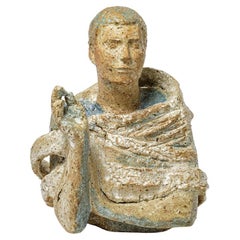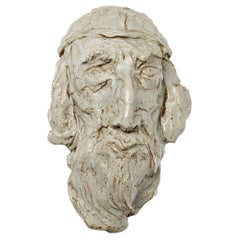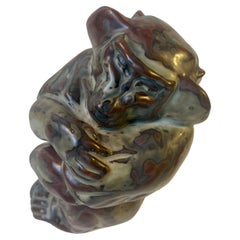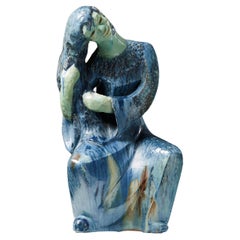La Borne Potters Figurative Sculptures
to
2
2
1
2
2
2
2
2
Height
to
Width
to
2
2
2
127
154
148
141
112
Creator: La Borne Potters
Large Stoneware Blue and Brown Figurativ Bust Sculpture circa 1960 Unique Piece
By La Borne Potters
Located in Neuilly-en- sancerre, FR
La Borne - french unique piece.
Large figurative ceramic bust by french artist
Realised circa 1970
Sonteware ceramic piece with blue and white ceramic glazes colors
Origi...
Category
Mid-20th Century French Mid-Century Modern La Borne Potters Figurative Sculptures
Materials
Ceramic
Glazed stoneware mask of Pieter Brueghel by Pierre Franchy, 1968.
By La Borne Potters
Located in Saint-Ouen, FR
Glazed stoneware mask of Pieter Brueghel by Pierre Franchy.
Artist signature under the base. 1968.
H : 10.8 x 6.8 x 3.5 inches.
Category
20th Century French Mid-Century Modern La Borne Potters Figurative Sculptures
Materials
Ceramic
Related Items
Glazed Stoneware Monkey by Knud Kyhn for Royal Copenhagen, 1950s
By Royal Copenhagen
Located in Esbjerg, DK
This series of elephants/mammoths, bears, monkeys etc was designed by the Danish ceramist Knud Kyhn (KK) all the way back in 1929-36. Hugely inspired by the sung glazes applied in Ax...
Category
1950s Danish Mid-Century Modern Vintage La Borne Potters Figurative Sculptures
Materials
Stoneware
$418 Sale Price
20% Off
H 5.91 in W 3.94 in D 3.94 in
Female Figurine Sculpture by Hassan Heshmat Egypt 1960s Blue Teal Stoneware
By Hassan Heshmat
Located in Stockholm, SE
Sculpture by Hassan Heshmat,
Egypt. 1960's.
Stoneware.
Unique.
Dimensions:
H: 52 cm/ 20 1/2''
Category
1960s Egyptian Mid-Century Modern Vintage La Borne Potters Figurative Sculptures
Materials
Stoneware
$3,489
H 20.48 in Dm 11.82 in
Wall-mounted relief in glazed stoneware by Birte Weggerby
By Birte Weggerby
Located in Copenhagen, DK
Wall-mounted relief in glazed stoneware with wooden frame. Signed on the back. 1969.
Category
Mid-20th Century Danish Mid-Century Modern La Borne Potters Figurative Sculptures
Materials
Stoneware
Unique III Stoneware Sculpture by Lisa Geue
Located in Geneve, CH
Unique III Stoneware sculpture by Lisa Geue
Dimensions: D 12 x W 10 x H 21.5 cm
Materials: Stoneware with Chamotte, Porcelain Slip, Kaolin, multiple firings
Non-functional.
Lis...
Category
2010s French Modern La Borne Potters Figurative Sculptures
Materials
Other
Martini Rossi advertising sculpture or bust, 1960s
Located in Leuven, Vlaams Gewest
Cool advertising sculpture or bust for Martini & Rossi to display a bottle in shops.
Great to use in our bar or as a decorative piece in your ho...
Category
1960s Italian Mid-Century Modern Vintage La Borne Potters Figurative Sculptures
Materials
Plaster
Large Sculpture Bust Classic Bronze
Located in Senonches, Centre-Val de Loire
Sculpture statue bust man bronze patina.
Superb effect in both classic and contemporary interiors, this piece will not leave anyone indifferent.
Its classic style inspired by the Greek Gods takes us back to a page of history that recalls the cult of the perfect body...
Category
21st Century and Contemporary French Classical Greek La Borne Potters Figurative Sculptures
Materials
Composition
California Studio Mid Century Glazed Stoneware Bird Sculpture by Robert Maxwell
By Robert Maxwell
Located in San Jose, CA
Vintage ceramic pottery stoneware zoo bird sculpture designed by Robert Maxwell circa 1960's in Venice, California. This slip-cast studio piece is reminiscent of a "toucan resting on...
Category
1960s American Mid-Century Modern Vintage La Borne Potters Figurative Sculptures
Materials
Ceramic
$380 Sale Price
20% Off
H 6 in W 5.5 in D 2.75 in
Danish Modern Glazed Stoneware Koi Fish by Aage Würtz, 1970s
Located in Esbjerg, DK
In Japanese culture the Koi fish symbolizes courage, perseverance, bravery and love simultaneously. This emblematic stoneware sculpture however was made in Denmark by Aage Würtz circ...
Category
1970s Danish Scandinavian Modern Vintage La Borne Potters Figurative Sculptures
Materials
Stoneware
Brown glazed stoneware sculpture by Simone Couderc, circa 1990-2000.
By La Borne Potters
Located in Saint-Ouen, FR
Brown glazed stoneware sculpture by Simone Couderc.
Artist signature under the base. Circa 1990-2000.
H : 9.2’ x 12.9’ x 4.3’ inches.
Category
21st Century and Contemporary French Beaux Arts La Borne Potters Figurative Sculptures
Materials
Ceramic
$3,008
H 9.26 in W 13 in D 4.34 in
Abstract Stoneware Sculpture by La Borne Potters, circa 1970, Signed
By La Borne Potters
Located in Saint-Ouen, FR
An abstract stoneware sculpture, circa 1970 by La Borne Potters.
Signed.
Unique piece.
Category
20th Century French Beaux Arts La Borne Potters Figurative Sculptures
Materials
Ceramic
$1,444
H 10.24 in W 11.03 in D 9.85 in
'The Fat Soldier' - Vintage Glazed Scandinavian Stoneware Figurine
Located in Esbjerg, DK
In the style of Lisa Larsson comes this chubby fella in uniform. It has delicate glazes and hilarious features like the stout nose and the jacket that splits over his stomach. It is ...
Category
1980s Scandinavian Mid-Century Modern Vintage La Borne Potters Figurative Sculptures
Materials
Stoneware
Bronze Glazed Stoneware Bust 'Mathilda' c1980
Located in Melbourne, AU
The bust has been sculpted from earthenware clay and fired with a Bronze glaze. It is sculpted in a mannered style, with a dramatic, expressively turned head and tender expression.
...
Category
1980s French Mid-Century Modern Vintage La Borne Potters Figurative Sculptures
Materials
Metal
$1,040 Sale Price
58% Off
H 17.92 in W 11.03 in D 9.85 in
La Borne Potters figurative sculptures for sale on 1stDibs.
La Borne Potters figurative sculptures are available for sale on 1stDibs. These distinctive items are frequently made of ceramic and are designed with extraordinary care. Many of the original figurative sculptures by La Borne Potters were created in the mid-century modern style in france during the mid-20th century. If you’re looking for additional options, many customers also consider figurative sculptures by and Line Vautrin. Prices for La Borne Potters figurative sculptures can differ depending upon size, time period and other attributes — on 1stDibs, these items begin at $2,404 and can go as high as $2,404, while a piece like these, on average, fetch $2,404.
Recently Viewed
View AllMore La Borne Potters Furniture
La Borne Potters Abstract Sculptures
La Borne Potters Animal Sculptures
La Borne Potters Table Lamps
La Borne Potters Vases and Vessels
La Borne Potters Ceramics
La Borne Potters Ceramics
La Borne Potters Pitchers
La Borne Potters Bowls and Baskets
La Borne Potters Boxes
La Borne Potters Tea Sets
La Borne Potters Wall Mirrors
La Borne Potters Platters and Serveware



